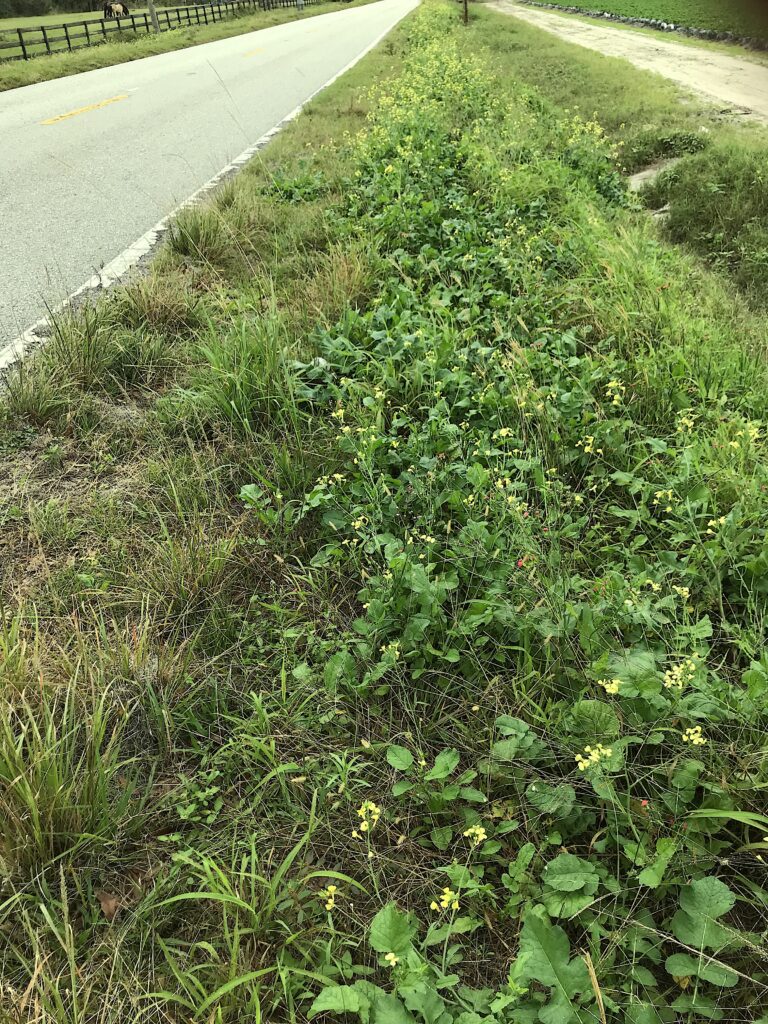
This is a common place to find mustard or radish plants, a streak of yellow blossoms beside the road. Photo By Green Deane
Some years the seasonal changes happen with regularity. This year has been irregular. Though cooler weather has yet to arrive locally Wild Mustard and Ringless Honey mushrooms are ahead of schedule. Indeed, the mustard is blossoming, and the mushrooms are weeks ahead of their usual time. Conversely, edible persimmons are late this year. That all makes one wonder how the winter weather might vary from the usual this year.
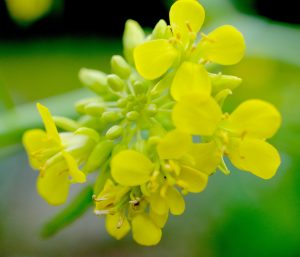
Blossoms can range from yellow to white. Photo by Green Deane
Mustards in the warm south likelate fall they do and I usually start writing about them in late November. In season you can see Wild Mustards and Wild Radish not only along roadsides but in various fields from farm land to ignored citrus groves. The two species are used interchangeably and look similar. However Wild Radishes tend to be serpentine rather than straight and tall like Wild Mustard. They also have lumpy seed pods, or, more lumpy than mustard seed pods. Usually you will find a stand of one or the other. I don’t recall ever finding both in the same patch. Blossom colors can range from yellow to white with streaks of purple. But the leaves always have the biggest lobe on the end farthest from the plant. Look for them in sunny areas with fertile soil. Not native they came from Eurasia in the 1700s. And note the seeds can remain viable in the soil for up to 60 years. To read more Wild Radish go here, and for Wild Mustard, here.
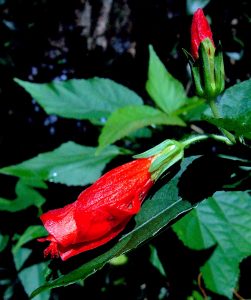
These hibiscus blossoms never open. Photo by Green Deane
We saw several species blooming this past weekend in my foraging classes. The Hibiscus were happy including the “Sleepy Hibiscus.” It’s a fairly easy shrub to identify because the bright red blossoms never unfurl. Also blossoming was the Bauhinia. It’s a tree that is both easy and challenging at the same time. The blossoms are edible, look nice in salads. Some of the species have edible seeds and some do not. (They are in the pea family and most pea trees — most not all — do not have edible seeds.) Sorting out which Bauhinia you have can be a challenge, nearly as bad as sorting out which Cereus you have. Like the Cereus cactus there are several man-made Bauhinia hybrids and perhaps even some fake botanical names. It can make species identification a real headache though as far as I know all the blossoms are edible. Only “discovered” 111 years ago the blossom of the Bauhinia blakeana is the emblem of Hong Kong. You can read about the Bauhinia here.
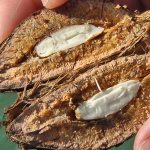
Tropical Almond’s “kernel” photo by Green Deane.
Tropical Almonds are now on Mother Nature’s dining table and we ate some during our recent foraging class in West Palm Beach. Terminalia catappa, which is really subtropical and not at all an almond, produces edible fruits for a few months. The ripe rind is edible as well as the “almond” inside which is really a little embryonic tree. It tastes like coconut9 blended with almonds. The only problem is the buoyant dry shells are quite tough and require a hammer or a couple of rocks to crack open. (For those who don’t know Florida does not have rocks. You can’t just rummage around and find a pair of rocks to break seed shells with.) There is some labor involved with eating Tropical Alomonds but they are still calorie positive. I usually have a couple of pieces of concrete hidden near this particular tree to get to the treat. To read more about the Tropical Almond go here.
Can two people independently come up with the same bad idea? The answer is yes when the idea is Daylight Savings Time, which we leave Nov 5th. A bug collector and a golfer in different parts of the world came up with the idea of Daylight Savings Time, and were correctly ignored until World War I. We flip forth and back every spring and fall though it now costs us more than it saves… Daylight Wasting Time or Daylight Slaving Time, take your pick… Only the government would cut a foot off one end of a blanket, sew it on to the other end and call the blanket longer. Personally I loathe the flipping and stopped doing so some 25 years ago. I stay on solar (standard) time and ignore Daylight Savings Time. So in a few days we will agree again. Not flipping is easy. I don’t change when I eat, go to bed, or feed the animals. I just ignore it. To read more about time change click here or here. Florida wrongly voted to stay on daylight savings time to avoid the flipping. But, as DST is a federal program the state needs congressional approval to opt out. Whereas no congressional permission is needed to stay on standard time. Hence, DST will haunt us again next spring.
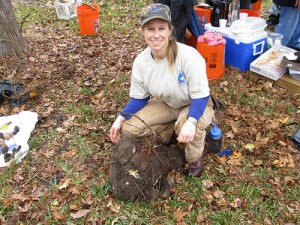 We’ve also been digging up a lot of wing Yam roots (Dioscorea alata.) While there are six species of “yams” locally the Winged Yam is the biggest caloric payoff. And it is a true yam not a variety of sweet potato (Ipomoea) which are improperly called “yams” and sold in cans and whole in grocery stores. Also called “Yam A” on my website we are interested in eating its root not its distinctive dark brown “air potatoes.” The plant’s root can grow to many pounds — 30 unattended, 150 cultivated — and is right below the surface usually. Boil it like a potato first then use like a potato. Its dark brown, misshapen “air potatoes” are quite visible this time of year hanging on the vine making it easy to find. As it’s seasonal demise is triggere by daylight hours you should be able to find it for a couple of more monhts. You can read more about the Winged Yam and others here.
We’ve also been digging up a lot of wing Yam roots (Dioscorea alata.) While there are six species of “yams” locally the Winged Yam is the biggest caloric payoff. And it is a true yam not a variety of sweet potato (Ipomoea) which are improperly called “yams” and sold in cans and whole in grocery stores. Also called “Yam A” on my website we are interested in eating its root not its distinctive dark brown “air potatoes.” The plant’s root can grow to many pounds — 30 unattended, 150 cultivated — and is right below the surface usually. Boil it like a potato first then use like a potato. Its dark brown, misshapen “air potatoes” are quite visible this time of year hanging on the vine making it easy to find. As it’s seasonal demise is triggere by daylight hours you should be able to find it for a couple of more monhts. You can read more about the Winged Yam and others here.
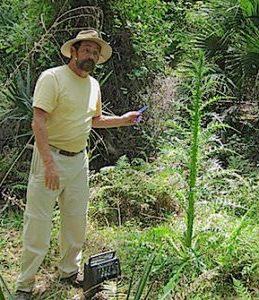
Foraging classes are held rain, shine, hot or cold. Photo by Nermina Krenata
Foraging Classes: The Wekiva Trail class also visits the Little Wekiva Rive Saturday.
Oct 28th, Seminole Wekiva Trail, Sanlando Park, 401 West Highland St. Altamonte Springs, Florida 32714. 9 a.m., meet at first parking lot on right.
Oct 29th Blanchard Park, 2451 Dean Rd, Union Park, FL 32817 9.a.m. met at the pavilion by the tennis courts.
To read more about the classes, to pre-pay or sign up, go here.

You get the USB, not the key.
150-video USB would be a good end of spring present and is now $99. My nine-DVD set of 135 videos has been phased out. The USB videos are the same videos I have on You Tube. Some people like to have their own copy. The USB videos have to be copied to your computer to play. If you want to order the USB go to the DVD/USB order button on the top right of this page. That will take you to an order form. I’d like to thank all of you who ordered the DVD set over the years which required me to burn over 5,000 DVDs individually.

Green Deane Forum
Want to identify a plant? Perhaps you’re looking for a foraging reference? You might have a UFO, an Unidentified Flowering Object, you want identified. On the Green Deane Forum we — including Green Deane and others from around the world — chat about foraging all year. And it’s not just about warm-weather plants or just North American flora. Many nations share common weeds so there’s a lot to talk. There’s also more than weeds. The reference section has information for foraging around the world. There are also articles on food preservation, and forgotten skills from making bows to fermenting food.
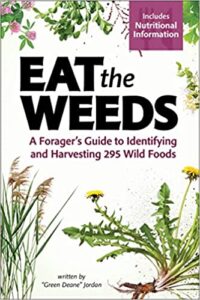 Now being printed is EatTheWeeds, the book. It should have 275 plants, 350-plus pages, index and color photos. Several hundred have been preordered on Amazon. And it is being printed now. Most of the entries include a nutritional profile. Officially it will be published December 5th (to suit the publisher publicity demands) and apparently to appeal to the winter market.
Now being printed is EatTheWeeds, the book. It should have 275 plants, 350-plus pages, index and color photos. Several hundred have been preordered on Amazon. And it is being printed now. Most of the entries include a nutritional profile. Officially it will be published December 5th (to suit the publisher publicity demands) and apparently to appeal to the winter market.
This is weekly newsletter #577. If you want to subscribe to this free newsletter you can find the sign-up form in the menu at the top of the page.


